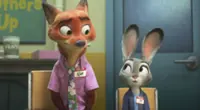After his sequel got canceled, Pennywise was forced to accept whatever horror role he could get. — Handout
Like any good horror buff, Sandberg knows that the best horror films need only a few well-honed elements to work: a group of young people, the aforementioned scary cabin, and in this case, clowns. The script is based on a PlayStation game written by horror filmmakers Larry Fessenden and Graham Reznick, who took inspiration from movies like Evil Dead and Poltergeist, and the film adaptation indeed boasts that Evil Dead influence in its setting, characters and gore factor.
But Until Dawn is also influenced by postmodern, self-referential films like The Cabin in the Woods and Happy Death Day that play with form and expectations. It melds horror tropes with the rules of video game play (repetition, multiple lives) resulting in a film that’s part genre tribute, part choose your own adventure, part interactive haunted house.
A group of comely young adults arrive at a strange “Welcome Center” while on a weekend trip to search for Melanie (Maia Mitchell), the sister of Clover (Ella Rubin), who has been missing for a year.
Clover’s friends Max (Michael Cimino), Megan (Ji-young Yoo) and Nina (Odessa A’zion) have come along for moral support, along with Abe (Belmont Cameli), Nina’s new boyfriend.
The ominously spooky vibes are off the charts, and things go very badly, very quickly for the friends. But then, an hourglass turns, time winds back. The friends are alive, battered and remember everything that happened. What horrific thing might kill them in the next time loop?
“Survive the night or become a part of it,” a crone whispers to Clover during her second loop, and therein lies the key to their survival. If they can manage to avoid getting killed until the sunrise, they’ll be fine (relatively), it’s just that every loop brings new nightmares, unknown dangers and different predators, never allowing the group to get ahead of things. They have to die, and die again, searching for a way out of this temporal maze. But how many chances do they have?
Sandberg works a familiar kind of schlocky groove, delivering well-worn horror stereotypes we’ve already seen too many times, before upending the whole thing with wild surprises. We’ve seen these players and the board before, but the filmmakers try to keep us on our toes with how the whole thing plays out.
The loop structure gives us more time with these characters too. Though they all slot into known archetypes – steely yet vulnerable final girl, condescending jock, sarcastic and sexy pal, sweet but sympathetic simp, kooky intuitive bestie – they’re all fully formed characters, sardonic and self-aware.
Sandberg isn’t trying to elevate Until Dawn above its B-movie horror roots, and he embraces the good, the bad and the gory with his return to the genre, referencing the beloved horror films that set the pace and established the iconography for a film like this (he even nods to his own horror films in a couple of playful tributes).
This one will likely only appeal to fans of the genre who appreciate reverence and twists on this kind of material, but it’s bloody – if lightweight – fun for those who enjoy this kind of good old-fashioned romp in the woods. – Tribune News Service
Summary:
Bloody fun for those who enjoy this kind of good old-fashioned romp in the woods.







